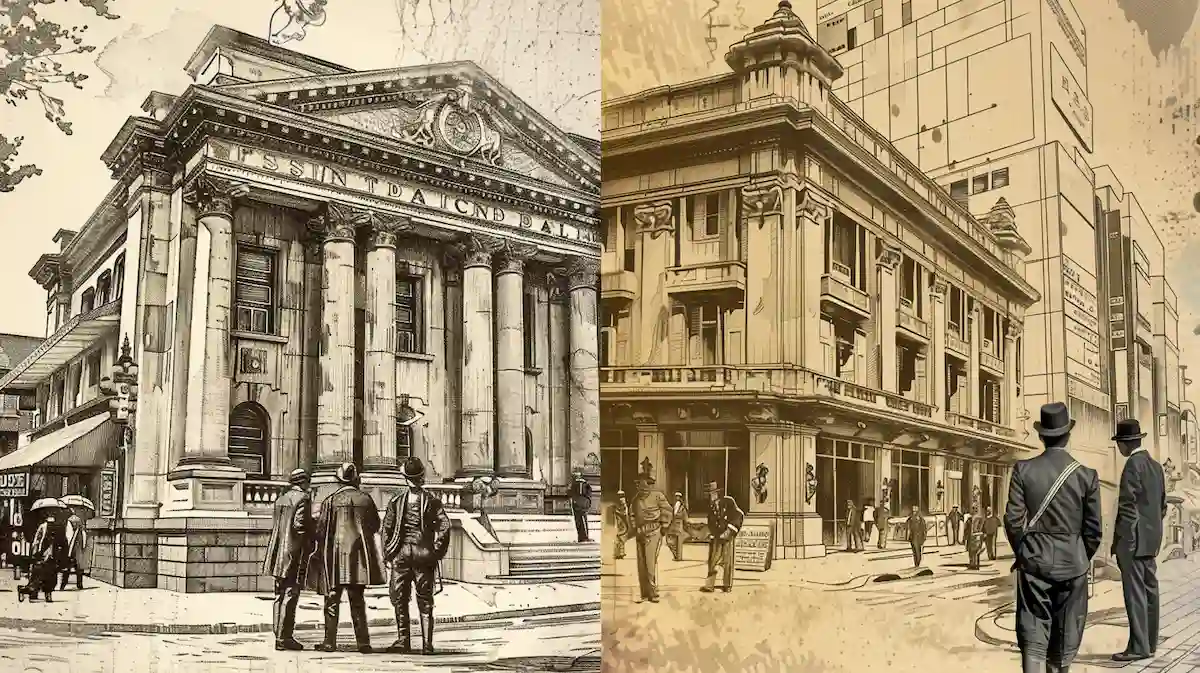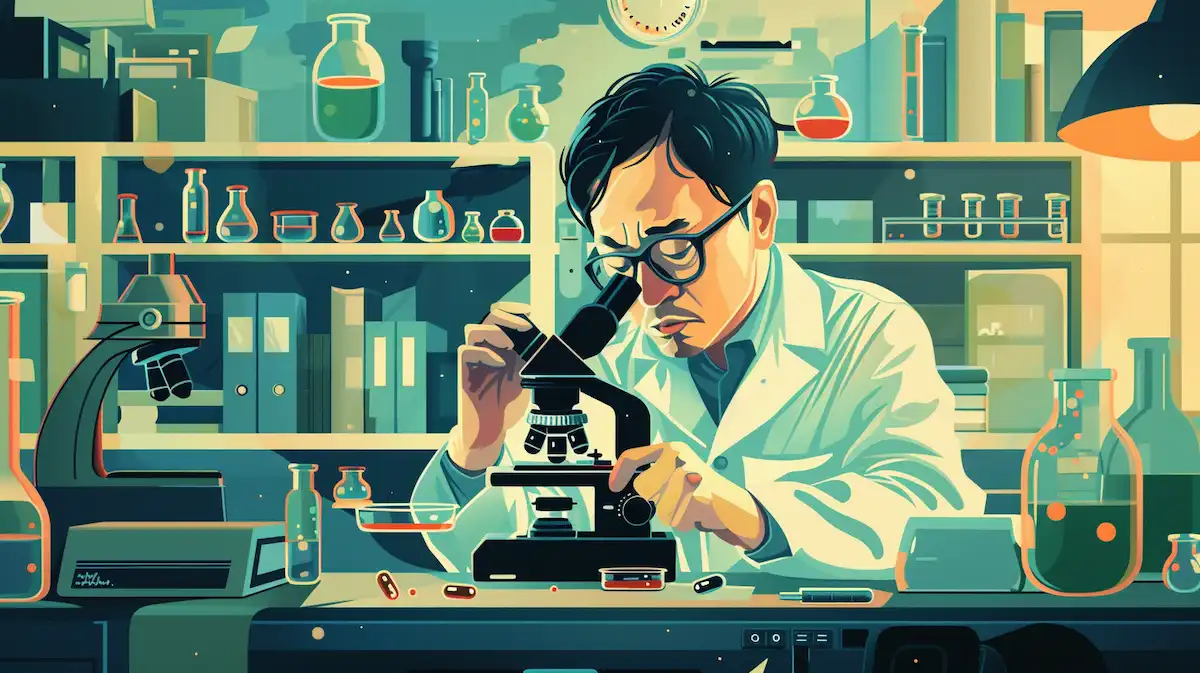北里柴三郎を英語で説明・紹介するための基本情報と、英会話に役立つ表現をシンプルでわかりやすい英語で紹介します。
英会話ダイアローグ・関連情報・10の質問を通して、北里柴三郎に関する英語表現を学びます。
英語
英会話ダイアローグを読む前に知っておくと良い前提知識と情報は以下の通りです。
- 北里柴三郎の基本情報
- 北里柴三郎(1853-1931)は日本の細菌学者で、破傷風菌の発見や破傷風抗毒素の開発で知られている
- 1894年には香港でペスト菌を発見し、その治療法を研究
- 1892年に伝染病研究所を設立し、日本の感染症研究の基盤を築いた
- 主要な業績
- 破傷風菌の純粋培養と破傷風抗毒素の発見
- 香港でのペスト菌の特定と予防法の研究
- 慶應義塾大学医学部の設立
- 教育と影響
- 多くの研究者や医師を育成し、特に野口英世などに大きな影響を与えた
- 独立自尊の精神
- 北里は「独立自尊」を重視し、自らの力で困難を乗り越える姿勢を持ち続けた
- 新紙幣への登場:
- 2024年7月3日に発行された新しい1,000円紙幣に、北里柴三郎の肖像を使用
2人が北里柴三郎について話しています。
北里柴三郎の主な業績である破傷風菌の発見や香港でのペスト菌の特定、教育者としての貢献や独立自尊の精神、新紙幣の肖像などを話題にしています。
会話 / dialogue

Hey Key, have you ever heard of Shibasaburo Kitasato?

Yeah, I’ve heard of him. He was a famous Japanese scientist, right? What got you interested in him?

I recently read that his portrait is on the new 1,000 yen banknote. It made me curious about his contributions and life.

That’s right! The new banknotes were issued on July 3, 2024. Kitasato was a pioneering bacteriologist. One of his major achievements was discovering the tetanus bacterium and developing the tetanus antitoxin around 1890.

That’s impressive. So, he helped treat tetanus effectively?

Exactly. Before his discovery, tetanus was often fatal. His work saved many lives.

I didn’t know that. What about his impact in Japan?

After returning to Japan, he founded the Institute of Infectious Diseases in 1892. This institute became a major center for disease research. He also established the medical school at Keio University, significantly advancing medical education in Japan.

He sounds like a real pioneer. I read that he had a strong belief in “independence and self-respect.” How did that influence his work?

Kitasato believed in forging his own path and maintaining his dignity. This belief helped him persevere through challenges, like his studies in Germany under Robert Koch, despite the language barriers and being in a foreign country.

I admire that. Did he mentor any other notable scientists?

Yes, one of his most famous students was Hideyo Noguchi. Noguchi studied under Kitasato at the Institute of Infectious Diseases. Kitasato’s mentorship was crucial in shaping Noguchi’s early career.

So, his influence extended beyond his own work. Any interesting episodes from his life?

There are many. For instance, during the plague outbreak in Hong Kong, he quickly identified the plague bacterium, which brought him international recognition. His efforts were vital in controlling the outbreak.

That must have been a significant achievement back then. It’s amazing how his work still impacts us today.

Absolutely. His spirit of dedication to science, education, and public health continues to inspire. That’s why his face on the new banknote is such an honor and a reminder of his legacy.

I see why he’s so respected. I’m glad I learned more about him. It’s fascinating how one person can make such a huge difference.

Definitely. If you’re interested, you could visit the Kitasato Institute or the memorial museums. They provide a lot of insight into his life and work.

That sounds like a great idea. Thanks for the suggestion, Key. I’ll definitely check it out.

You’re welcome, Mack. It’s always great to learn about such inspiring figures in history.
関連情報 / related information
「北里柴三郎」について、理解を深めるための「英語での関連情報」です。
北里柴三郎

Early Life and Education
Shibasaburo Kitasato was born in 1853 in Japan. He studied medicine at the University of Tokyo. After graduating, he went to Germany to study under Robert Koch, a famous bacteriologist.
Major Achievements
Kitasato made important discoveries in the field of bacteriology. In 1889, he successfully cultured the tetanus bacterium. In 1890, he developed the tetanus antitoxin, which could treat people infected with tetanus. His work saved many lives.
Plague Research
In 1894, during a plague outbreak in Hong Kong, Kitasato identified the plague bacterium. This discovery was crucial for controlling the disease. His research helped to prevent the spread of the plague.
Contributions to Japan
After returning to Japan, Kitasato founded the Institute of Infectious Diseases in 1892. He also established the medical school at Keio University. These institutions became important centers for medical research and education in Japan.
Mentorship and Influence
Kitasato trained many young scientists, including Hideyo Noguchi, who became a famous bacteriologist. Kitasato’s guidance and support were key to Noguchi’s success.
Legacy and Recognition
Kitasato believed in independence and self-respect. He overcame many challenges through his own efforts. In honor of his contributions, Kitasato’s portrait is featured on the new 1,000 yen banknote issued in 2024. His work continues to inspire scientists and medical professionals today.
10の質問 / 10 questions
「北里柴三郎」について、理解を深めるための「英語での10の質問」です。
1: Who was Shibasaburo Kitasato?
Shibasaburo Kitasato was a Japanese bacteriologist known for his important discoveries in infectious diseases, including the development of the tetanus antitoxin.
2: What did Kitasato discover?
Kitasato discovered the tetanus bacterium and developed the tetanus antitoxin, which saved many lives by preventing tetanus infections.
3: When did Kitasato identify the plague bacterium?
In 1894, during a plague outbreak in Hong Kong, Kitasato identified the bacterium responsible for the plague, helping to control the disease.
4: What role did Kitasato play in Japanese medical education?
Kitasato founded the Institute of Infectious Diseases in 1892 and established the medical school at Keio University, advancing medical research and education in Japan.
5: How did Kitasato influence Hideyo Noguchi?
Kitasato mentored Hideyo Noguchi at the Institute of Infectious Diseases, shaping Noguchi’s early career and contributing to his success as a bacteriologist.
6: What is the significance of Kitasato's work on tetanus?
Kitasato’s work on tetanus was groundbreaking because he was the first to isolate the bacterium and develop an antitoxin, which became a crucial treatment for the disease.
7: What were Kitasato's core beliefs?
Kitasato believed in "independence and self-respect," values that guided him through many challenges in his research and personal life.
8: What honor did Kitasato receive in 2024?
In 2024, Kitasato’s portrait was featured on Japan’s new 1,000 yen banknote, recognizing his contributions to science and medicine.
9: Where did Kitasato study abroad, and under whom?
Kitasato studied in Germany under the famous bacteriologist Robert Koch, where he conducted important research on infectious diseases.
10: What impact did Kitasato have on global health?
Kitasato’s discoveries, such as the tetanus antitoxin and his work on the plague, had a global impact by improving treatments for infectious diseases and saving lives around the world.
和訳付
会話 / dialogue

Hey Key, have you ever heard of Shibasaburo Kitasato?
やあキー、北里柴三郎って聞いたことある?

Yeah, I’ve heard of him. He was a famous Japanese scientist, right? What got you interested in him?
うん、聞いたことあるよ。有名な日本の科学者だよね?どうして彼に興味を持ったの?

I recently read that his portrait is on the new 1,000 yen banknote. It made me curious about his contributions and life.
最近、彼の肖像が新しい1000円札に載ってるって読んだんだ。彼の功績や人生について興味が湧いてね。

That’s right! The new banknotes were issued on July 3, 2024. Kitasato was a pioneering bacteriologist. One of his major achievements was discovering the tetanus bacterium and developing the tetanus antitoxin around 1890.
そうだよ!新しい紙幣は2024年7月3日に発行されたんだ。北里は先駆的な細菌学者だったんだ。彼の主な功績の一つは、1890年頃に破傷風菌を発見し、破傷風抗毒素を開発したことだよ。

That’s impressive. So, he helped treat tetanus effectively?
すごいね。じゃあ、彼が破傷風の効果的な治療に貢献したってことか。

Exactly. Before his discovery, tetanus was often fatal. His work saved many lives.
そのとおり。彼の発見以前は、破傷風はしばしば致命的だったんだ。彼の研究は多くの命を救ったんだよ。

I didn’t know that. What about his impact in Japan?
そうだったんだ。日本での影響はどうだったの?

After returning to Japan, he founded the Institute of Infectious Diseases in 1892. This institute became a major center for disease research. He also established the medical school at Keio University, significantly advancing medical education in Japan.
日本に戻ってからは、1892年に伝染病研究所を設立したんだ。この研究所は病気研究の主要センターになったんだよ。それに、慶應義塾大学に医学部を設立して、日本の医学教育を大きく前進させたんだ。

He sounds like a real pioneer. I read that he had a strong belief in “independence and self-respect.” How did that influence his work?
本当に先駆者だったんだね。彼は「独立自尊」を強く信念としていたって読んだんだけど、それは彼の仕事にどう影響したの?

Kitasato believed in forging his own path and maintaining his dignity. This belief helped him persevere through challenges, like his studies in Germany under Robert Koch, despite the language barriers and being in a foreign country.
北里は自分の道を切り開き、尊厳を保つことを信じていたんだ。この信念が、ロベルト・コッホの下でのドイツ留学など、言葉の壁や異国での生活といった困難を乗り越える力になったんだよ。

I admire that. Did he mentor any other notable scientists?
感心するね。他に有名な科学者を指導したりしたの?

Yes, one of his most famous students was Hideyo Noguchi. Noguchi studied under Kitasato at the Institute of Infectious Diseases. Kitasato’s mentorship was crucial in shaping Noguchi’s early career.
うん、彼の最も有名な弟子の一人に野口英世がいるんだ。野口は伝染病研究所で北里の下で学んだんだ。北里の指導は野口の初期のキャリアを形作る上で重要だったんだよ。

So, his influence extended beyond his own work. Any interesting episodes from his life?
じゃあ、彼の影響は自分の研究以外にも及んだんだね。彼の人生で何か面白いエピソードはある?

There are many. For instance, during the plague outbreak in Hong Kong, he quickly identified the plague bacterium, which brought him international recognition. His efforts were vital in controlling the outbreak.
たくさんあるよ。例えば、香港でのペスト流行の際に、彼は素早くペスト菌を特定して、国際的な評価を得たんだ。彼の努力が流行の制御に不可欠だったんだよ。

That must have been a significant achievement back then. It’s amazing how his work still impacts us today.
当時としては大きな功績だったんだろうね。彼の仕事が今でも影響を与えているって、すごいよね。

Absolutely. His spirit of dedication to science, education, and public health continues to inspire. That’s why his face on the new banknote is such an honor and a reminder of his legacy.
その通りだよ。科学、教育、公衆衛生への彼の献身的な精神は今でも人々に刺激を与え続けているんだ。だから、新しい紙幣に彼の顔が載ることは、彼の遺産を思い出させる名誉なことなんだよ。

I see why he’s so respected. I’m glad I learned more about him. It’s fascinating how one person can make such a huge difference.
なるほど、彼がそんなに尊敬されている理由がわかったよ。彼についてもっと知れてよかった。一人の人間がこんなに大きな違いを生み出せるなんて、すごく興味深いね。

Definitely. If you’re interested, you could visit the Kitasato Institute or the memorial museums. They provide a lot of insight into his life and work.
そうだね。もし興味があれば、北里研究所や記念館を訪れてみるといいよ。彼の人生と仕事について多くの洞察が得られると思うよ。

That sounds like a great idea. Thanks for the suggestion, Key. I’ll definitely check it out.
いいアイデアだね。提案してくれてありがとう、キー。絶対に行ってみるよ。

You’re welcome, Mack. It’s always great to learn about such inspiring figures in history.
どういたしまして、マック。歴史上のこういう感動的な人物について学ぶのは、いつも素晴らしいことだよね。
関連情報 / related information
北里柴三郎

Early Life and Education
Shibasaburo Kitasato was born in 1853 in Japan. He studied medicine at the University of Tokyo. After graduating, he went to Germany to study under Robert Koch, a famous bacteriologist.
北里柴三郎は1853年に日本で生まれました。彼は東京大学で医学を学びました。卒業後、彼は有名な細菌学者ロベルト・コッホのもとで学ぶためにドイツに行きました。
Major Achievements
Kitasato made important discoveries in the field of bacteriology. In 1889, he successfully cultured the tetanus bacterium. In 1890, he developed the tetanus antitoxin, which could treat people infected with tetanus. His work saved many lives.
北里は細菌学の分野で重要な発見をしました。1889年に破傷風菌の培養に成功しました。1890年には破傷風抗毒素を開発し、破傷風に感染した人々を治療できるようにしました。彼の仕事は多くの命を救いました。
Plague Research
In 1894, during a plague outbreak in Hong Kong, Kitasato identified the plague bacterium. This discovery was crucial for controlling the disease. His research helped to prevent the spread of the plague.
1894年、香港でペストが流行した際、北里はペスト菌を特定しました。この発見は病気を制御するために重要でした。彼の研究はペストの拡散を防ぐのに役立ちました。
Contributions to Japan
After returning to Japan, Kitasato founded the Institute of Infectious Diseases in 1892. He also established the medical school at Keio University. These institutions became important centers for medical research and education in Japan.
日本に帰国後、北里は1892年に伝染病研究所を設立しました。彼はまた、慶應義塾大学医学部も設立しました。これらの施設は、日本における医学研究と教育の重要な拠点となりました。
Mentorship and Influence
Kitasato trained many young scientists, including Hideyo Noguchi, who became a famous bacteriologist. Kitasato’s guidance and support were key to Noguchi’s success.
北里は多くの若い科学者、特に有名な細菌学者となった野口英世を育てました。北里の指導と支援は、野口の成功に重要な役割を果たしました。
Legacy and Recognition
Kitasato believed in independence and self-respect. He overcame many challenges through his own efforts. In honor of his contributions, Kitasato’s portrait is featured on the new 1,000 yen banknote issued in 2024. His work continues to inspire scientists and medical professionals today.
北里は独立と自尊を信じていました。彼は自分の努力で多くの困難を乗り越えました。彼の貢献を称えて、2024年に発行された新しい1,000円紙幣には北里の肖像が描かれています。彼の業績は今日も科学者や医療専門家に影響を与え続けています。
10の質問 / 10 questions
1: Who was Shibasaburo Kitasato?
北里柴三郎とは誰ですか?
Shibasaburo Kitasato was a Japanese bacteriologist known for his important discoveries in infectious diseases, including the development of the tetanus antitoxin.
北里柴三郎は、破傷風抗毒素の開発を含む、感染症に関する重要な発見で知られる日本の細菌学者です。
2: What did Kitasato discover?
北里は何を発見しましたか?
Kitasato discovered the tetanus bacterium and developed the tetanus antitoxin, which saved many lives by preventing tetanus infections.
北里は破傷風菌を発見し、破傷風抗毒素を開発しました。この抗毒素は破傷風の感染を防ぎ、多くの命を救いました。
3: When did Kitasato identify the plague bacterium?
北里はいつペスト菌を特定しましたか?
In 1894, during a plague outbreak in Hong Kong, Kitasato identified the bacterium responsible for the plague, helping to control the disease.
1894年、香港でペストが発生した際、北里はペストの原因となる細菌を特定し、病気の制御に貢献しました。
4: What role did Kitasato play in Japanese medical education?
北里は日本の医学教育にどのような役割を果たしましたか?
Kitasato founded the Institute of Infectious Diseases in 1892 and established the medical school at Keio University, advancing medical research and education in Japan.
北里は1892年に伝染病研究所を設立し、慶應義塾大学の医学部を設立して、日本の医学研究と教育を発展させました。
5: How did Kitasato influence Hideyo Noguchi?
北里は野口英世にどのような影響を与えましたか?
Kitasato mentored Hideyo Noguchi at the Institute of Infectious Diseases, shaping Noguchi’s early career and contributing to his success as a bacteriologist.
北里は伝染病研究所で野口英世を指導し、彼の初期のキャリアを形成し、細菌学者としての成功に貢献しました。
6: What is the significance of Kitasato's work on tetanus?
北里の破傷風研究の意義は何ですか?
Kitasato’s work on tetanus was groundbreaking because he was the first to isolate the bacterium and develop an antitoxin, which became a crucial treatment for the disease.
北里の破傷風研究は画期的で、彼は初めて破傷風菌を分離し、抗毒素を開発しました。この抗毒素は病気の治療において重要なものとなりました。
7: What were Kitasato's core beliefs?
北里の主要な信念は何でしたか?
Kitasato believed in "independence and self-respect," values that guided him through many challenges in his research and personal life.
北里は「独立自尊」を信念として持ち、研究や個人生活の多くの困難を乗り越える指針としていました。
8: What honor did Kitasato receive in 2024?
北里は2024年にどのような栄誉を受けましたか?
In 2024, Kitasato’s portrait was featured on Japan’s new 1,000 yen banknote, recognizing his contributions to science and medicine.
2024年、北里の肖像が日本の新しい1,000円紙幣に採用され、彼の科学と医学への貢献が認められました。
9: Where did Kitasato study abroad, and under whom?
北里はどこで、誰のもとで留学しましたか?
Kitasato studied in Germany under the famous bacteriologist Robert Koch, where he conducted important research on infectious diseases.
北里はドイツで有名な細菌学者ロベルト・コッホのもとで学び、感染症に関する重要な研究を行いました。
10: What impact did Kitasato have on global health?
北里は世界の健康にどのような影響を与えましたか?
Kitasato’s discoveries, such as the tetanus antitoxin and his work on the plague, had a global impact by improving treatments for infectious diseases and saving lives around the world.
北里の発見(破傷風抗毒素やペストに関する研究)は、感染症の治療を改善し、世界中で多くの命を救うという世界的な影響を与えました。
words & phrases
英会話ダイアローグと関連情報に出てきた単語・フレーズです(例文は各3つ)。

tetanus : 名詞
意味: 破傷風。A serious bacterial infection that affects the nervous system and causes muscles throughout the body to tighten.
(破傷風菌の発見と破傷風抗毒素の開発に関連して使用)
例文
- Tetanus is a potentially fatal disease if not treated promptly.
「破傷風は、迅速に治療されない場合、致命的な病気です。」 - The vaccine for tetanus needs to be updated every ten years.
「破傷風のワクチンは10年ごとに更新する必要があります。」 - Kitasato discovered the bacterium that causes tetanus.
「北里は破傷風の原因となる細菌を発見しました。」
bacterium (単数形): 名詞 /複数形はbacteria
意味: 細菌。A microscopic single-celled organism that can cause disease.
(破傷風菌やペスト菌など、細菌に関する研究に関連して使用)
例文
- The bacterium responsible for cholera was identified in the 19th century.
「コレラの原因となる細菌は19世紀に特定されました。」 - Bacteria can be found in almost every environment on Earth.
「細菌は地球上のほぼすべての環境に存在します。」 - Kitasato successfully cultured the tetanus bacterium.
「北里は破傷風菌の培養に成功しました。」
plague : 名詞
意味: 疫病。A contagious bacterial disease characterized by fever and delirium, typically with the formation of buboes.
1894年の香港でのペストの発見と研究に関連して使用される)
例文
- The Black Plague killed millions of people in the 14th century.
「黒死病は14世紀に何百万もの人々を殺しました。」 - Modern medicine has significantly reduced the impact of the plague.
「現代医学はペストの影響を大幅に減少させました。」 - Kitasato identified the bacterium responsible for the plague in Hong Kong.
「北里は香港でペストの原因となる細菌を特定しました。」
fatal : 形容詞
意味: 致命的な。Causing death.
(破傷風が致命的である可能性について説明する際に使用)
例文
- Without prompt treatment, tetanus can be fatal.
「迅速な治療がなければ、破傷風は致命的になり得ます。」 - The accident had fatal consequences.
「その事故は致命的な結果をもたらしました。」 - Some diseases can be fatal if not treated in time.
「いくつかの病気は、適切な時期に治療されないと致命的になることがあります。」
persevere : 動詞
意味: 粘り強く続ける。To continue trying to achieve something despite difficulties.
(北里がドイツ留学中に困難に直面しても研究を続けたことを説明する際に使用)
例文
- Kitasato persevered in his studies despite many challenges.
「北里は多くの困難にもかかわらず研究を続けました。」 - It is important to persevere when facing obstacles.
「障害に直面したときに粘り強く続けることは重要です。」 - She persevered with her project until it was completed.
「彼女はプロジェクトが完了するまで粘り強く続けました。」
詳細情報 / Further Info
関連記事



